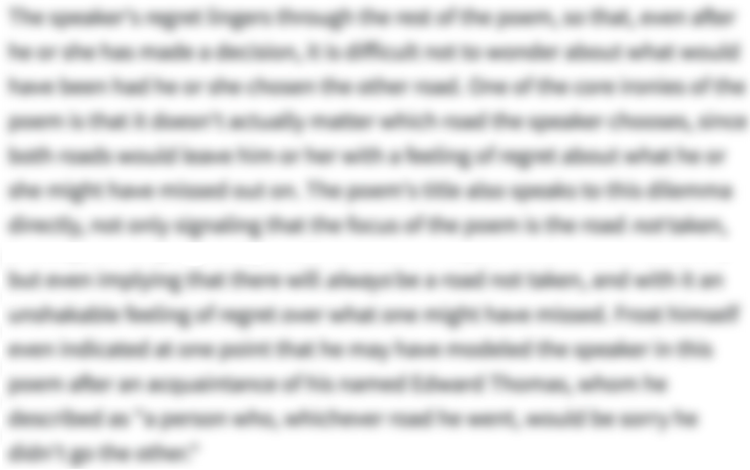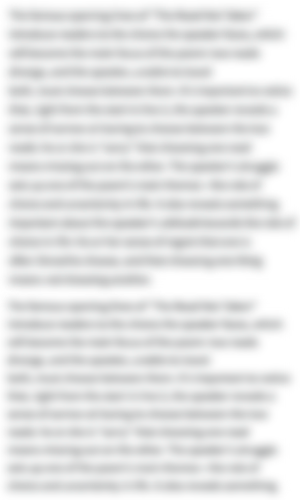The Full Text of “Silver”
1Slowly, silently, now the moon
2Walks the night in her silver shoon;
3This way, and that, she peers, and sees
4Silver fruit upon silver trees;
5One by one the casements catch
6Her beams beneath the silvery thatch;
7Couched in his kennel, like a log,
8With paws of silver sleeps the dog;
9From their shadowy cote the white breasts peep
10Of doves in a silver-feathered sleep;
11A harvest mouse goes scampering by,
12With silver claws and a silver eye;
13And moveless fish in the water gleam,
14By silver reeds in a silver stream.
-
“Silver” Introduction
-
"Silver" was written by the English author Walter de la Mare and published in his 1913 book of children's poems, Peacock Pie. The poem personifies the moon as a female presence who walks through the night, bathing objects and creatures in her beautiful "silver" glow. As she transforms the landscape, the world seems to draw to a standstill: a dog sleeps in its kennel, "moveless fish" rest in a stream, and so on. The poem thus testifies to the enchanting power of nature and nighttime.
-
-
“Silver” Summary
-
The moon travels through the night slowly and silently, wearing silver shoes. As she looks around in different directions, she sees silver fruit hanging from silver trees. Under silvery thatched rooftops, each window catches the moonlight in turn. A dog sleeps soundly in his kennel, his paws glinting with silvery moonlight. In their dark little shelter, white-breasted doves sleep, their feathers also bathed in silver light. A harvest mouse scuttles past, its claws and eyes shining like silver. Fish rest in the silvery stream, their scales shining next to silver reeds.
-
-
“Silver” Themes
-

The Transformative Beauty of Nature
"Silver" seeks to capture the enchanting beauty of a moonlit night. The speaker marvels at the moon's ability to suffuse the everyday world with wonder, presenting the moon as a kind of benevolent goddess peering into every corner of the world below. The moonlight here is not only beautiful in itself but also a source of transformative power: it makes everything else—even common, everyday objects—appear suddenly beautiful, too.
As the moon “silently” walks the night in her “silver shoon” (or shoes), she casts a lovely, silvery glow on everything she touches. Fruit trees, windows, rooftops, sleeping dogs, sheltering doves, mice, fish—all of these become "silver" in the moonlight. Common objects that might go unnoticed in the daytime become enchanting and wonderful in the quiet of the moonlight.
Such is the strength of this enchantment that it seems to cast a kind of spell over the land, making time stand still in tribute to the moon's power. The dog and the doves remain asleep as the moon moves through the night. Only a little mouse "scampers" across the ground. The fish in the stream, though their scales shine like silver, don't seem to move at all. Almost everything, then, lies suspended in this disarmingly beautiful moment.
The poem thus speaks to the beauty and wonder of nature, and the quiet enchantment of the nighttime in particular. It also, perhaps, subtly asks the reader to appreciate this beauty: to pause and observe the natural world closely.
- See where this theme is active in the poem.
-
-
Line-by-Line Explanation & Analysis of “Silver”
-
Lines 1-4
Slowly, silently, now the moon
Walks the night in her silver shoon;
This way, and that, she peers, and sees
Silver fruit upon silver trees;"Silver" begins by personifying the moon. The speaker presents it as a kind of female deity (as it is in many ancient myths) suffusing the world with magical silver light. The poem was originally written for children, and capturing a sense of child-like wonder is one of its main aims.
Notice how the first line delays the arrival of the main subject (the moon), instead offering two adverbs upfront: "slowly" and "silently." This little trick makes the opening suspenseful (contrast it with "The moon walks slowly and silently"). These two words, along with the title, also establish the poem's use of sibilance ("slowly, silently"). Whispery /s/ sounds occur throughout "Silver" and add to its hushed atmosphere of enchantment.
The moon walks the night wearing silver footwear ("shoon"), her steps spreading her gentle light. She is like a god surveying her work: the darting caesurae in line 3—"this way, and that, she peers, and sees"—mimic rapid glances and show how she covers the land far and wide. More sibilance, some of it alliterative, occurs in "silver shoon," "This," "she peers," "sees," "Silver," and "silver trees," capturing the extent of the moon's transformative power. The repetition of "silver"—already mentioned three times—has a spell-like quality, recurring throughout the poem and evoking the moonlight's magical, hypnotic properties.
-
Lines 5-6
One by one the casements catch
Her beams beneath the silvery thatch;

Unlock all 244 words of this analysis of Lines 5-6 of “Silver,” and get the Line-by-Line Analysis for every poem we cover.
Plus so much more...
Get LitCharts A+ -
Lines 7-10
Couched in his kennel, like a log,
With paws of silver sleeps the dog;
From their shadowy cote the white breasts peep
Of doves in a silver-feathered sleep; -
Lines 11-14
A harvest mouse goes scampering by,
With silver claws and a silver eye;
And moveless fish in the water gleam,
By silver reeds in a silver stream.
-
-
“Silver” Symbols
-

Doves
Within the overall context of the poem, "doves" are just one kind of creature among many resting under the moon's spell. But doves are also longtime symbols of peace. In fact, this symbolism stretches all the way back to ancient Greece.
In a poem that's already quiet and gentle, the presence of doves—let alone sleeping ones!—makes the atmosphere even more peaceful. All the troubles of waking life seem remote as the moon transforms the land into a scene of placid beauty. The dozing doves add to this effect on a symbolic, as well as literal, level. Just imagine if they were hawks or crows instead!
- See where this symbol appears in the poem.
-
-
“Silver” Poetic Devices & Figurative Language
-
Alliteration
Alliteration is an important part of the poem, filling it with beautiful, peaceful music that helps bring the beautiful, peaceful landscape to life for the reader. Much of this alliteration is also sibilance, and this device has its own section in the guide. In general, the /s/ alliteration serves the same function as the other examples: to create a hushed yet charged atmosphere of enchantment and transformation.
Almost every example of alliteration comes as a pair of sounds. This mimics the poem's other notable pairings: the rhymed couplets. Such neat, deliberate patterning helps create a sense of magic, as though the moon casts not only a visual spell on the landscape but also a linguistic spell on the poem. The non-/s/ examples all come together in lines 5-7:
One by one the casements catch
Her beams beneath the silvery thatch;
Couched in his kennel, like a log,These have an incantatory quality, like a chant. They also highlight the gradual effect of the moon, the way each object in the landscape seems to get switched on—like a light—by the moon's rays. "Casements catch," then, "catches" its alliterative sound just as the moon's light turns the windows silver.
- See where this poetic device appears in the poem.
-
Caesura


Unlock all 225 words of this analysis of Caesura in “Silver,” and get the poetic device analyses for every poem we cover.
Plus so much more...
Get LitCharts A+ -
Enjambment
-
Personification
-
Diacope
-
Sibilance
-
Simile
-
-
“Silver” Vocabulary
Select any word below to get its definition in the context of the poem. The words are listed in the order in which they appear in the poem.
- Shoon
- Casements
- Thatch
- Couched
- Cote
Shoon-
Shoes.
- See where this vocabulary word appears in the poem.
-
Form, Meter, & Rhyme Scheme of “Silver”
-
Form
"Silver" is a type of sonnet is known as a couplet or Clare sonnet, after the poet John Clare. This means that the poem has 14 lines broken into seven couplets.
Other sonnet types tend to have more elaborate rhyme schemes and traditionally feature a volta (sudden shift in direction) around line 9 or line 13. Here, the apparent lack of a volta reflects the poem's atmosphere of peace and serenity. That said, the personified moon does subtly disappear from the poem after line 6, her explicit presence giving way to the effect of her moonbeams. Perhaps this could be characterized as a turn, but if so, it's a very subtle one.
The use of couplets gives the poem a slow, methodical quality that matches the work of the moon. Much as the moon moves across the land, gradually illuminating objects and creatures, the poem moves unhurriedly, rhyme by rhyme, toward its conclusion.
-
Meter
The primary meter in "Silver" is four-beat accentual meter. This means that each line contains four stressed beats, but where those beats fall varies somewhat. You can hear this for yourself if you read the poem aloud and tap a hand or foot each time you say a strongly stressed syllable. Here's a look at lines 1-2:
Slowly, silently, now the moon
Walks the night in her silver shoon;The rhythm moves around a lot, but the number of stresses per line remains (relatively) constant.
Some lines in the poem also fit the pattern of iambic tetrameter or trochaic tetrameter. This means that they contain either four iambs (metrical feet with alternating unstressed-stressed beats) or four trochees (the opposite: feet with stressed-unstressed beats). Lines 5 and 6 offer examples of trochaic tetrameter and iambic tetrameter, respectively:
One by | one the | casements | catch
Her beams | beneath | the sil- | very thatch;("Silvery" here counts as two syllables, not three; "silv'ry.")
Accentual meter is often found in nursery rhymes and children's verse—like "Silver." As handled by de la Mare, it sounds simple, natural, and beautifully clear.
-
Rhyme Scheme
"Silver" consists of rhymed couplets. Its overall rhyme scheme is simple:
AABBCCDDEEFFGG
This simplicity suits a poem originally written for children. Each rhyme pair rings out clearly and satisfyingly to the reader's ear: "moon"/"shoon," "sees"/"trees," "catch"/"thatch," "log"/"dog," "peep"/"sleep," "by"/"eye," "gleam"/"stream." These steady, dependable rhymes help portray the moon's work as methodical and deliberate. She walks through the night, touching each object, animal, and feature of the landscape with silvery magic. The rhymes also take on a spell-like quality, adding to the magical atmosphere.
-
-
“Silver” Speaker
-
The speaker doesn't really feature in the poem—"Silver" is all about the moon! The lack of an "I" keeps the focus where the poet wants it: on the enchanting, transformative qualities of moonlight.
The poem feels more magical because the reader seems to be witnessing some kind of secret ritual, upon which no human being—speaker or otherwise—intrudes. That said, the speaker's style of expression does contribute to the magic. The speaker mentions "silver" ten times (eleven, counting the title!), as if reciting a chant or spell, and uses sibilant words (e.g., "slowly" and "shadowy") to conjure a hushed nocturnal atmosphere.
-
-
“Silver” Setting
-
"Silver" is set on an enchanted moonlit night. In fact, the entire poem is about the way the moon creates this sense of enchantment. The poem tracks the moon as she moves across the landscape, suffusing objects and creatures—most of which are pretty ordinary in the daytime—with a special, silvery magic. So enchanting is her spell that the poem feels like a snapshot of a world frozen in moonlight. Here, virtually everything is still, and everything is silver.
The poem features a notable lack of contemporary details, even by the standards of 1913. Instead, words like "casements" and "thatch" seem to situate the poem far in the past (not many roofs are made with thatch anymore). This seems to be a rural setting, given the presence of thatched houses—likely cottages—as well as fruit trees, a stream, and a harvest mouse. (Harvest mice tend to live among reeds, long grass, and crops like wheat and oats.) But these details aren't specific to one time or place; they're more evocative of a timeless, magical atmosphere, in keeping with de la Mare's poetry more generally.
-
-
Literary and Historical Context of “Silver”
Literary Context
Walter de la Mare (1873-1956) was a British author who wrote across a range of genres: the novel, the short story, drama, and, of course, poetry. Much of his work, including this poem, was written for children. De la Mare admired kids for living "in a world peculiarly their own, so much so that it is doubtful if the adult can do more than very fleetingly reoccupy that far-away consciousness."
"Silver," which appeared in his much-loved 1913 children's collection, Peacock Pie, contains a mix of enchantment, mystery, and childlike wonder. It speaks to what de la Mare called the "exquisite," "comprehensive" imagination of childhood "solitude"—the imagination in the years before adulthood has shorn the world of its enchanting qualities. Perhaps no poem captures these qualities better than de la Mare's most famous work, "The Listeners," which Thomas Hardy (a writer whom de la Mare knew and admired) called "possibly the finest poem of the century."
De la Mare is something of a singular figure in the history of English literature. He shares some common ground with British Romantic poets such as William Wordsworth and John Keats, particularly in his interest in childhood and the transformative powers of nature and the imagination. But he also possesses a sense of the uncanny that sets him apart. He was anthologized alongside poets like Hillaire Belloc, Robert Graves, and Edward Thomas in a group called the "Georgian poets," yet he doesn't fit neatly into this group either stylistically or thematically. De la Mare's poetry fell out of fashion after his death, but in recent years, it's begun to find new readers and appreciation.
Historical Context
De la Mare worked in the statistics department of Standard Oil (a huge oil company) for 18 years, writing on the side when he could. Eventually, he secured a pension that allowed him to write full-time. "Silver," published in the collection Peacock Pie (1913), appeared relatively early in de la Mare's writing career. It also appeared early in England's "Georgian era" (1910-1936), named after King George V—and just a year before the start of World War I.
When war broke out, de la Mare was too old for compulsory service. Though he did write some patriotic war poetry (e.g., "How Sleep the Brave"), his work was never dominated by political issues. In fact, his poetry and fiction chiefly aim to escape the particulars of historical and social context, preferring to conjure up a more mysterious, timeless world.
-
More “Silver” Resources
-
External Resources
-
Peacock Pie — The full text of the 1913 collection in which "Silver" appeared.
-
The Poem Out Loud — Listen to "Silver" read out loud.
-
More Poems and a Biography — A Poetry Foundation feature on the poet's life and work.
-
Anthony Hecht on Walter de la Mare — A short overview of de la Mare's life and work, by American poet Anthony Hecht.
-
More on the Georgians — An overview of the loose group of poets, including de la Mare, who were known as the Georgians.
-
-
LitCharts on Other Poems by Walter De La Mare
-








